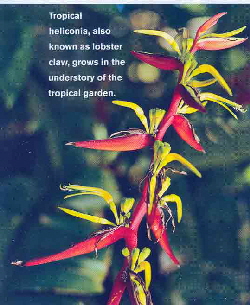 With the purchase of an adjacent property, the Childresses inherited a small olive grove, which seemed perfect for a Mediterranean garden.
With the purchase of an adjacent property, the Childresses inherited a small olive grove, which seemed perfect for a Mediterranean garden.
It soon became clear that Childress' "park" would consist of theme gardens, each representing a different geographical region of the world. Allthe gardens together would make up Pikake Gardens.
Over time Morse and the Childresses brought each theme garden to life. They created an English Garden, a Prayer Garden and a Desert Garden. With help from protea expert Ben Gill, they created a garden of plants in the protea family, native to Australia and South Africa. And, of course, Connie got her rose garden. Her initial thought was to plant seven or eight roses. Instead, Connie's rose garden has more than 300 roses, all arranged in an octagon and surrounding a central fountain.
The Mediterranean garden features plants native to the Mediterranean basin and includes a pavilion modeled after traditional Mediterranean pergolas.
The Pan-Asian garden is one of the most impressive of the Pikake Gardens. It is also Clyde's pride and joy.
The three-quarter-acre garden is modeled after Japanese gardens and incorporates many of the traditional elements - trees, shrubs, rocks, hills, ponds, and flowing water - all arranged in a way that imitates nature. As the garden developed, elements from other Asian countries were added, hence the "Pan-Asian" moniker.
Entry to the Pan-Asian garden is through the round Moon Gate Morse built of stone quarried from the site of Cal State San Marcos.
Through the gate, Morse built a rock waterfall that feeds the first and smallest of three ponds in the Pan-Asian garden. He edged it with papyrus, bamboo and a variety of water-loving plants.
The ponds are the central feature of the Pan-Asian garden. Water from the falls flows through the small pond, down to a medium-sized center pond and eventually makes its way to a 60 foot-diameter pond at the bottom.
Along the way, water passes beneath a tall, arched Edo Bridge with bright-red rails. The bridge separates the central pond from the lower pond. At the same time, it links the lushly planted banks to a lovely pagoda whose roof is made of authentic black tiles traditional for a Japanese garden structure. "I sent the dimensions of the roof to Japan," says Clyde, "and they made the tile to fit the roof. The roof is curved and each piece of tile has its own position, just like a puzzle."
Willow trees drape each pond. The fine foliage is the perfect contrast to vast patches of round, green lotus leaves. Inthe heat of summer, delicate pink and yellow lotus flowers dot the foliage. Large koi slip in and out between the lotus stems, coming ro the surface for a nibble of fish food and then dipping back down to avoid hungry herons and egrets.
Simulated Bog
¬ A zigzag Yatsuhashi Bridge spans the lower pond. Clyde explains the jagged shape ensures that evil spirits trying to cross the bridge will fall off and drown.
Evil spirits may not survive but ducks, dragonflies and birds are present in abundance. Though there are two sets of mechanical water filters, waste from the fish and birds made the water too murky to see much deeper than a few inches. Solving the clarity problem was one of Morse's greatest challenges.
Morse plumbed the ponds so that water from the lowest pond is pumped back up to the waterfall at the top, an elevation change of about 25 feet. What opportunities, he wondered, did the situation offer for novel solutions? How could he supplement the mechanical filters to clarify the water?
Morse thought about bogs. A natural bog is a wetland filled with plants that pull nutrients from waterlogged soils. So, Morse reasoned, why not create a simulated bog as a natural filtering system to clarify the water?
One hundred tons of gravel and countless water plants later, Morse had created a 50-foot-by-30-foot bog densely planted in cannas, horsetail, papyrus, taro, yellow and blue flag iris, water hyacinth, watercress and more. As water is pumped through the gravel, the stones and the plant roots draw out the particulates. The more the water is pumped through the system, the clearer the water gets. The result pleased Morse immensely. The Childresses were pleased as well.
Botanic Garden
With its diversity of theme gardens and plants, Morse says he told Clyde that he considers Pikake Gardens more a botanic garden than a park. The observation surprised Clyde. "I never thought of this as a botanical garden," he says. "I thought of it as a park. The rest grew as it took a life of its own." Once the idea was planted, Childress had Pikake Gardens certified as a private botanical garden.
Building Pikake Gardens is an ongoing process with challenges and successes, discoveries and delights. "The benefits have far outweighed the challenges," says Connie, "We've met some wonderful people. It has been a wonderful experience. I wouldn't have traded it for anything.".
Resources:
Artist & Contractor:¬ Bryan Morse, Expanding Horizons¬ (760)¬ 941-5450 www.expandinghorizons.biz
Electrical: Steve Hill (760) 749-7279
Protea Garden: Ben Gill, California Protea Management (800) 423-6445 www.californiaproteamgmt.com
Wood Structures: Mahlon Morse, SF Renovation & Custom Built-in Woodworking (415)¬ 931-5500 http://www.sfrenovations.com
Call: (760) 505-7900 Email: bryan@expandinghorizons.biz
© 2018 Expanding Horizons is a part of the Omni Pragma® family All rights reserved.

